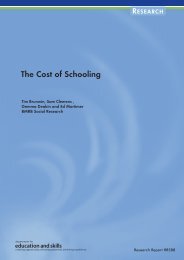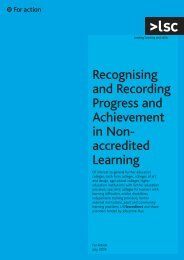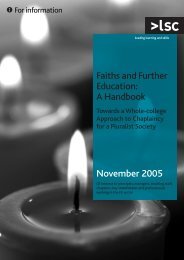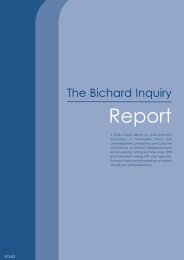Full Text (PDF) - Official Documents
Full Text (PDF) - Official Documents
Full Text (PDF) - Official Documents
Create successful ePaper yourself
Turn your PDF publications into a flip-book with our unique Google optimized e-Paper software.
Managing the expansion of the Academies Programme Part Three 43<br />
Comparability of financial information<br />
3.31 The Department has made progress in publishing data on academies’ income and<br />
expenditure. In July 2012, it published academy trusts’ first set of ‘Abbreviated Accounts<br />
Returns’, setting out detailed income and expenditure from academy trusts’ 2010/11<br />
statutory accounts.<br />
3.32 These returns are similar to ‘Consistent Financial Reporting’ for maintained schools,<br />
but are not directly comparable. Academies’ expenditure is not classified using the same<br />
categories, and their income includes, but does not separately identify, capital funding<br />
and grants such as LACSEG (see Part Two) which do not feature in maintained school<br />
figures. The next round of Abbreviated Accounts Returns, covering 2011/12, will present<br />
academy figures in a format more comparable with those of maintained schools.<br />
3.33 Abbreviated Accounts Returns show data at academy trust, rather than individual<br />
academy, level. The figures are therefore a composite of all academies within the trust,<br />
each of which may serve a different community in a different part of the country. In<br />
2010/11, of the 319 individual academies included in the data, 133 (42 per cent) belonged<br />
to one of the 29 multi-academy trusts producing such composite accounts, and hence<br />
did not have individual academy-level data. Abbreviated Accounts Returns for 2011/12<br />
will continue to show data at academy trust level, although the Department has recently<br />
improved the transparency of individual academies’ income by publishing academy-level<br />
funding allocations on its website.<br />
Evaluating value for money<br />
3.34 Our 2010 report on the Programme found that existing academies had performed<br />
impressively in delivering intended improvements, but that their performance to date was<br />
not necessarily a predictor of future impact, particularly given the changing population<br />
of schools making up the Programme. We recommended that the Department state<br />
its objectives for the expanded Programme, and how it would measure success<br />
against them.<br />
3.35 In September 2012, the Department published high-level value-for-money<br />
principles for academies and maintained schools within its revised Accountability<br />
System Statement. It is also developing a more detailed value-for-money framework for<br />
academies. This sets out how financial inputs might be analysed against educational<br />
outcomes, but does not yet specify baselines, how the Department is comparing data<br />
on improvement and costs to support ongoing programme implementation, nor when<br />
it intends to measure progress. These points need clarifying so that the Department<br />
and others can understand how the Programme is progressing and, in the longer term,<br />
whether it delivers value for money.

















